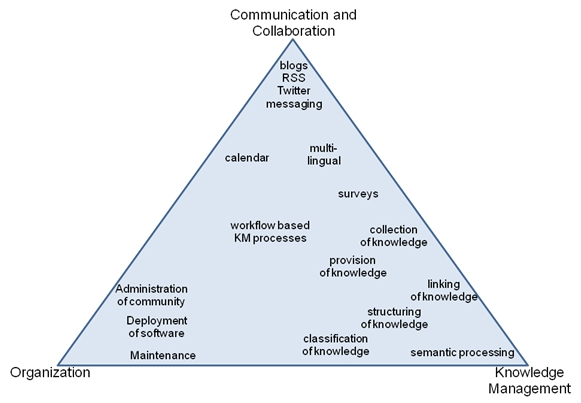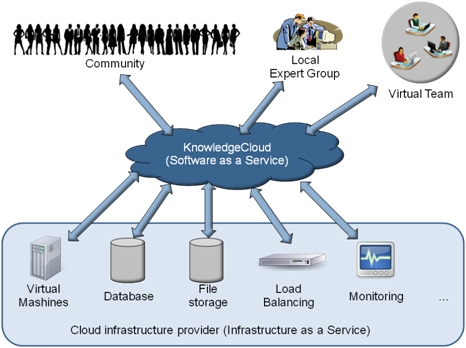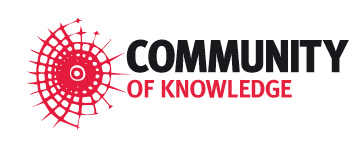Beiträge
Themengruppen
Recherche
Service
- Was ist Wissensmangement?
- Open Journal of Knowledge Management
- Artikel-Guidelines
- Newsletter
- Kalender
- Wissensmanagement-Anbieter
- Partner
- Mediadaten
Community
Sponsoren


- Community of Knowledge. (2011). Website of Community of Knowledge. Retrieved May 3, 2010, from www.community-of-knowledge.de.
- Dryndos, J., Kazi, A. S., Langenberg, D., Löh, H., & Stark, R. (2008). Collaborative Virtual Engineering for SMEs: Technical Architecture. In K.-D. Thoben, K. S. Pawar, & R. Gonçalves (Eds.), 14th International Conference on Concurrent Enterprising (ICE) 2008, pp. 507–514. Retrieved from www.ice-proceedings.org/Projects/408/ICE 2008/Virtual Engineering & Manufacturing/060 - CWE14 2_ICE2008_CoVES_Technical_Architecture SS4 IP2_3.pdf.
- Foster, I., Kesselman, C., & Tuecke, S. (2001). The anatomy of the grid: Enabling scalable virtual organizations. International Journal of High Performance Computing Applications, 15(3), pp. 200-222.
- Foster, I., Zhao, Y., Raicu, I., & Lu, S. (2008). Cloud Computing and Grid Computing 360-Degree Compared. 2008 Grid Computing Environments Workshop, Vol. abs/0901.0, pp. 1-10. IEEE. doi: 10.1109/GCE.2008.4738445.
- Haghirian, P. (2004). Interkultureller Wissenstransfer- strategisch unverzichtbar für Global Player. In: Wissensmanagement- Das Magazin für Führungskräfte, No. 4, pp. 48–50.
- Hall, E. T. & Hall, M. R. (1990). Understanding cultural differences.
- Hayka, H., Langenberg, D., & Stark, R. (2010). Kooperationsplattformen für virtuelle Unternehmen. ZWF Zeitschrift für wirtschaftlichen Fabrikbetrieb, 105(7-8), pp. 693-699.
- Hofstede, G. H. (1993). Interkulturelle Zusammenarbeit: Kulturen-Organisationen-Management.
- Knoof, T. (2007). Wissen vermehren dank neuer Community-Strategien. In: Wissensmanagement- Das Magazin für Führungskräfte, No. 8, pp. 44–45.
- Pumacy Technologies. (2011). Website about KMmaster. Retrieved February 23, 2011, from www.kmmaster.com.
- Reisach, U. (2008). Kulturelle Unterschiede im Umgang mit Wissen - Beispiele aus der Wirtschaftspraxis in Deutschland, USA und China. In: Gronau, Norbert/ Eversheim, Walter (Hg.): Umgang mit Wissen im interkulturellen Vergleich. Beiträge aus Forschung und Unternehmenspraxis. acatech Workshop Potsdam 20.Mai 2008. Stuttgart: Fraunhofer IRB Verlag (acatech diskutiert), pp. 97–125.
- Stark, R., Hayka, H., & Langenberg, D. (2009). New potentials for virtual product creation by utilizing grid technology. CIRP Annals - Manufacturing Technology, 58(1), pp. 143-146. doi: 10.1016/j.cirp.2009.03.066.
- Welker, M. "Analyse und Bewertung der kulturellen Besonderheiten von Internet Communities zum Themenschwerpunkt Wissensmanagement", Diplomarbeit, Westsächsische Hochschule Zwickau, 2009.
Knowledge management in virtual communities
16. Mai 2011 von Dirk Langenberg, Melanie WelkerPeople with common interests meet in communities to exchange their knowledge. Today, these communities are organized virtually in the internet. Geographical as well as cultural borders do not exist anymore – theoretically. In practise, these communities need support for their communication and their knowledge transfer in order to keep the members together. This paper summarizes the main results of a study, which analyses the cultural differences of communities in different regions of the world. Further on it describes possibilities, how software solutions support the collaborative work in transcultural communities and how a future solution might look like.
This articel was also published in Open Journal of Knowledge Management, Issue III/2011.
1 Background
Part of many discussions in the press, in the TV, but also in weblogs or social networks, today´s keyword is “globalization” and its various aspects and influences on economical events and behaviour. Nowadays, there exist visible tendencies in the development of mergers, acquisitions and co-operations of enterprises from different branches. More and more of these mergers and acquisitions operate and take place in an international context. The “global” thinking is lively embedded in smaller, locally concentrated but also in transnational-oriented enterprises. Over the last years, the possibilities to communicate between enterprises, organizations, research institutions and universities have enlarged and intensified. As per Xing founder (a social network to establish business contacts) “everyone knows everyone through maximum six corners. [...] if everyone knows everyone through six corners, the whole implicit and explicit knowledge of the world should be available through maximum six corners at the same time.” (Knoof 2007, 44). Employees or resources as the ones who are strongly involved into this communication seem to be more and more important. Only with global knowledge transfer and intercultural communication across borders and countries, they can face today´s challenges. Therefore, human-beings and resources can be seen as key elements in organizations and their economic success.
In the context of knowledge management a wide variety of different virtual communities in the internet can be found. For example newsgroups, social networks and weblogs just to name some of them. People from different countries and cultures who are interested in exchanging on topics or ideas have the chance to get in contact with each other through these virtual communities. Even though these methods and tools have been developed in the global environment, today´s requirements for knowledge management communities have changed during the last years.
On the one hand, they should support the international cross links (economical, technical and social) between organizations and therefore enable or facilitate knowledge transfer activities within these organizations. On the other hand, they should also try to minimize geographical distance and language barriers between users and overcome intercultural barriers and communication problems within these cultures. Technically speaking, there exist different tools for these requirements in knowledge management communities, one of them will be presented later.
When treating topics like globalization as part of new working conditions, modern communication technologies and resources of organizations in the centre of all that - the impact of intercultural behaviour and cultural differences cannot be excluded. The “cultural distance” (Haghirian 2004, 40), as well as “different languages (...) and country-specific interpretations” (Reisach 2008, 106) can play a certain role in cyberspace communication, because they might have a strong influence on the communication itself. As part of a study in 2009, altogether 25 knowledge management communities have been analysed regarding more than 11 cultural oriented success indicators. Through this international comparison of knowledge management communities, the classification of cultural areas by Hall and Hofstede could be proved.
The following chapter deepens the classification of cultural areas by Hall and Hofstede by highlighting different cultures, behaviour and relationships (paragraph 2). Different cultures and cultural backgrounds do have an influence on communication in general, but furthermore on communication in virtual surroundings. With respect to these different situations, the authors propose software functionalities which can face these changing requirements (paragraph 3). Finally, this study shows first results of the realisation of a knowledge management and collaboration service (paragraph 4).
2 Classification of cultural areas by Hall and Hofstede
To prove, whether cultural differences and country-specific interpretations have an influence on communication, the classification of cultural areas by Hall and Hofstede can be one possibility. The three dimensions help to detect a possible relation between the handling with modern communication technologies in the internet and cultural behaviour of people from different countries.
The first dimension to classify cultures is called Individualism – Collectivism (see table one). This dimension illustrates the impact of the individual or the group within a culture and to what extent they can belong to a social structure. The second dimension Monochronic – Polychronic describes the relation to time and the handling with time (see table two). And the third dimension Low Context – High Context shows behaviour and attitudes towards information gathering and the usage of communication tools and how different cultures use modern technologies (see table three).
Table 1: Individualism – Collectivism (according to Hofstede)
Individualism | Collectivism |
|---|---|
Autonomy, Identity from the individual | Integration into networks, social environment gives identity |
Loose connection between people, personal responsibility | Integration into strong, bonding groups, protection |
Direct, open, honest, sincere | Indirect, not linear, prefer harmony |
e.g. USA and Europe | e.g. Spain, Latin America, Asia |
Table 2: Monocronic – Polycronic (according to Hall)
Monochronic | Polychronic |
|---|---|
Time is linear | Time is not linear |
Exact planning, interruptions should be avoided | Improvisation, interruptions are normal |
Several actions are executed one after another | Several actions can be executed in parallel |
Analytical, systematically, punctual | Intuitive, unpunctual |
e.g. USA, Northern Europe, Germany | e.g. Spain, France, Italy, Asia |
Table 3: Low Context – High Contect (according to Hall)
Low Context | High Context |
|---|---|
Communication is explicit | Communication more implicit, much information to be found in the context |
Direct, clear way of communication | Indirect, ambiguous way of communication |
Specific need in information | Specific need in social interaction, wide network |
Short and loose interpersonal relations | Long and deeper interpersonal relations |
Internet use: person - message – interaction | Internet use: person - person - interaction |
Search for information through click on hyperlinks | Use of comments, feedback, online discussions, newsgroups |
e.g. USA, Northern Europe, Germany Switzerland | e.g. Spain, France, Italy, Asia, Latin America |
3 Role of software as a supporting tool for Internet communities
3.1 Aspects of possible support
Virtual communities like the Community of Knowledge (Community of Knowledge, 2011) consist of a large number of people, who are communicating in the internet and exchange views on specific subjects. They are similar to virtual organizations (VO) in many aspects. VO is a temporary consortium or alliance of companies that work together with a common goal (Dryndos, et al., 2008). Both, VOs as well as communities need support for data sharing, for communication and for sharing of resources across organizational borders. In the case of VOs various collaboration platforms are established, which provide most of these functionalities (Hayka, Langenberg, & Stark, 2010). However, communities are using wikis, forums, and newsgroups, today. We propose several possibilities for additional support which can be adopted from virtual organizations.
Support for virtual communities by using collaboration and knowledge management software platforms has to meet several challenges. Firstly, communication between the community members has to be improved to reduce the geographical and cultural distances. Secondly, simplified and effective sharing of knowledge has to be enabled. A structured knowledge base is an important step to (re)use common knowledge. Thirdly, management of a community has to be simplified. Figure 1 summarizes the different possibilities for software support in Internet communities.

Figure 1: Software assistance for knowledge management and collaboration in Internet communities
3.2 Support for communication
When we take a look at the communication aspects, we see at first the current Web 2.0 communication technologies. Especially the internet-based communities ask for the integration of these tools (weblogs, RSS and Twitter-Feeds) into their collaboration environment. These tools help to reduce the distance between the community members virtually and to enable more interactions and spontaneous discussions. Of course, “traditional” communication tools are needed, too. To send email messages is still required. For the communication it is important, to provide diverse solutions in the common platform because of the different cultures. For example the collectivism cultures choose approaches for open discussion in their groups. Other cultures are more focussed on the individual by using direct email or weblogs, which are focussed on the author’s opinion.
Another approach for more interaction inside of the community is to deploy workflows. Today, every member can create input and it is stored in the knowledge base. Perhaps another member reads and validates it – but not necessarily. So the quality of knowledge items in these knowledge bases varies a lot. This phenomenon is visible in most communities, even in the well known Wikipedia community. The implementation of workflows, which enforce reviews for every article before its publication, involves more people in the creation process and ensures a higher level of quality of documented knowledge. Finally, the knowledge becomes more a result of the entire group and new discussions are started. However, workflows mean a big change in collecting knowledge. Especially internet communities with many volunteers prefer open and less restrictive publication processes. So workflows have to be implemented in common-sense and adequate to the behaviour in the community.
Of course, there are other ways to assist interaction between community members. The knowledge platform could include further functionalities for collaboration. For example, common calendars for meetings and task management support the planning of monochromic cultures, tools for surveys and voting realize forming of opinions in collectivism influenced communities and support for implementing social networks strengthen the integration into bonding groups.
For acceptance in international communities, it is very important that the common platform is multi lingual. In many countries it is preferred to use the native language. At least the graphical user interface has to support different languages. All members should use it intuitively and should feel integrated into the community. For huge international communities, it is useful to write knowledge articles in different languages. The platform should support this multi lingual knowledge management.
3.3 Support for collaborative knowledge management and organizational challenges
Main functionality of the software platform is the management of the community’s knowledge. It has to support collection, structuring and provision of knowledge. There are different approaches for knowledge management, for example to use a freely semi-structured wiki or a management system for knowledge articles with predefined structures. The community has to decide which approach is to be used. Independent of the chosen approach, cross linking between all knowledge items in the platform is important. There are explicit links, which are set by the users. They describe how articles are connected. Also the members can connect themselves, like it is known in social platforms. On the other side, there are various implicit links between knowledge. Categories, tags, or meta information like authors and creation time express correlations. Especially for the high context cultures this implicit knowledge is interesting, because it describes the background of an article. It is a challenge for future knowledge management platforms to make use of this implicit knowledge.
To improve the management of virtual communities, technical barriers have to be solved. Typically, the maintainers like all members of a community are interested in the domain specific topics – and not in running an information technology infrastructure. Therefore a ready-to-use solution of a specialized provider is required. Then the entire community can focus all efforts on their own topics.
4 Future platform for virtual communities
A future platform supports the community in their collaborative work based on the described functions. At first, currently arising cloud technologies give virtual communities new possibilities to operate their infrastructure. Cloud computing is a further development of grid computing technologies (Stark, Hayka, & Langenberg, 2009), which FOSTER defined some years ago as: “Grid Computing is concerned with coordinated resource sharing and problem solving in dynamic, multi-institutional virtual organizations.”(Foster, Kesselman, & Tuecke, 2001). Cloud computing shares the same vision (Foster, Zhao, Raicu, & Lu, 2008). Especially the current trend, providing software as a service (SaaS) on a pay-per-use basis, is interesting for virtual communities. They can buy the required IT-solution including (virtualized) hardware, setup, operation and maintenance (backups and security patches), for example a complete knowledge management and collaboration platform.
The knowledge management system KnowledgeCloud is an example for such a SaaS solution, which is currently developed in a research project by Pumacy Technologies. Based on the experiences in the knowledge management area and the know-how gained with the implementation of the knowledge management software KMmaster (Pumacy Technologies, 2011) Pumacy is developing KnowledgeCloud, a knowledge management platform with a new architecture based on cloud technologies and providing collaboration-oriented knowledge management as a service (see Figure 2). So it is accessible from everywhere in the internet and none community member has to host the solution. At the same time, the availability is much higher than most community members would typically achieve.
Figure 2: Knowledge management as a service on basis of Cloud Computing technologies
In the future, communities will use collaborative knowledge management service with many of the functionalities described above to support their common work. With the software services like KnowledgeCloud, members of the communities will be in the position to work together anywhere in the world across organizational and cultural boundaries.
Acknowledgement
The presented results with respect to the knowledge management platform KnowledgeCloud have partly been developed during the project KnowledgeCloud. The project KnowledgeCloud lasts from July 2010 until December 2011. It is co-funded by the German Government (Bundesministerium für Wirtshaft und Technik, BMWi, EP101090) and supervised by EuroNorm.
Literature
Kommentare
Das Kommentarsystem ist zurzeit deaktiviert.
Themengruppen
Dieser Beitrag ist den folgenden Themengruppen zugeordnet
Schlagworte
Dieser Beitrag ist den folgenden Schlagworten zugeordnet

